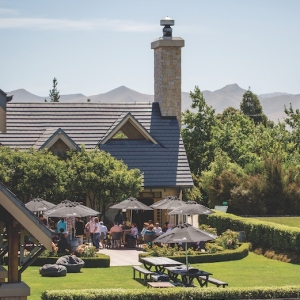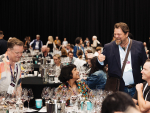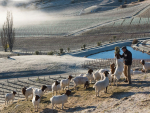“We have a region where everyone’s starting to hit their straps at roughly the same time in terms of the knowledge they have of their styles and vineyards,” noted Simon McGeorge, winemaker at Waipara Hills. “Most vineyards have now been here for quite some time, with 10 to 15 year-old vines tending to make more interesting wines.”
Once a fairly fragmented region, there’s also a feeling now of greater fraternity amongst its producers. This has been illustrated by recent collaborative initiatives such as tastings outside the region hosted by a group of North Canterbury growers, as well as the creation of a new marketing arm for the Waipara Valley region.
“There seems to be a level of cohesiveness between a number of producers in the region that I’ve not seen in the 25 odd years I’ve been involved in the local industry,” observes Pegasus Bay’s Ed Donaldson. “There’s now a group of producers that all have similar objectives and have a like-mindedness with regards to how we get there, without any negative competitiveness and a realisation that the success of an individual producer helps grow the reputation of the region, which in turn helps everyone.”
Several decades after the region’s wine industry started to get established, Waipara is coming of age. With this has come change, most evidently a period of consolidation. Wineries have changed hands and most recently the major multinational, Accolade Wines become the second major company, after Pernod Ricard, to take a branded stake in the region through its acquisition of the Mud House Wine Group and its Waipara Hills label.
Accolade officially took control of the branded part of New Zealand Vineyard Estate’s business on 1st April. The latter has now been renamed New Zealand Wineries and remains the owner of Waipara Hill’s prominent cellar door building and winery on State Highway 1, which has been contracted by Accolade to continue to make the label’s wines and run the tasting room as before.
“Having such a big player in Waipara could be very important for the region and should benefit everybody,” McGeorge says.
Despite this growing multinational presence, Waipara remains largely a region of boutique players, albeit one that has seen some expand through acquiring other wineries. Greystone purchased its neighbour, Muddy Water in 2011 and more recently Dancing Water (which previously acquired the Floating Mountain label and winery) took over Fiddler’s Green last June.
“This complements the varieties we make from our existing vineyard and has allowed us to secure our fruit supply,” explains Dancing Water’s Claire Bisso. “As Fiddler’s Green has such strong brand recognition in the Canterbury market, we’ll be retaining the label and just injecting some new energy into it.”
A number of other vineyards are currently on the market, such as those of Dunnolly Estate wines as the owners concentrate on the winemaking and business side of the venture rather than grape growing. Northfield has also divested itself of its Home Creek holding, to more strongly focus its Californian estate, but is “committed to continuing our grape growing and winemaking in Waipara” and retaining its Frog Rock vineyard.
There have also been changes in Waipara’s winemaking personnel. Following the sudden departure of Mountford’s longtime winemaker, CP Lin, Theo Coles is now directing winemaking at the estate. Coles had earlier left his family company, Crater Rim and started his consultancy business, Natural Wine Solutions, which also sees him making wine for Waikari’s Arden Estate.
After 20 years, Lynnette Hudson has left Pegasus Bay. She now runs Lynnette Hudson Wine Consulting Services out of Auckland and is winemaker and one of six partners in the recently established Waipara-predominant Tongue in Groove brand, fronted by ex-Greystone marketer, Angela Clifford.
Despite the fall in visitor figures to the region immediately following the Christchurch earthquakes, new cellar doors are still managing to open. These include Black Estate’s acclaimed cellar door and restaurant, which is proving a draw to the region, and Bishop’s Head boutique tasting room that finally opened last year after a protracted licence application.
Tourism appears to be bouncing back in the region, as well as the local Christchurch trade.
Waipara has become increasingly active in promoting what has become to be regarded at its flagship grape, Riesling. This has ranged from running the In Praise of Riesling events to the focus in more recent years on Summer of Riesling initiatives that this year saw the region hosting a major national Riesling tasting.
“Demand for Riesling is increasing,” says Penelope Naish of Black Estate. “In the Auckland market it’s really popular, it’s a best seller in the restaurant and it’s been strong in Australia.”
Waipara Pinot Noir is also starting to deliver its promise and attract growing attention through high profile awards, such as Greystone’s win of the Pinot Noir Trophy at the last Air New Zealand Wine Awards.
While it is Sauvignon Blanc that’s perhaps surprisingly the region’s most widely planted grape (much of which is in a single large vineyard), there has been experimentation with new varieties. Chenin Blanc is one of these, wines from which have been successfully made by Bishop’s Head for some years now, with Black Estate on the cusp of commercial production.
Another exciting development is the findings of soil studies conducted in the region by Lincoln University, which discovered that “Canterbury has the most diverse soil of any New Zealand region”, according to Professor Roland Harrison of the university’s Faculty of Agriculture and Life Sciences. As well as offering the region’s winegrowers greater insight into their own terroir, this information is being collated for communication to visitors at the region’s cellar doors.
“We’re getting a lot of international profile for the North Canterbury area and people are starting to ask about the difference in Waipara, Omihi and Waikari,” observes Mavromatis. “I guess this is a sign of maturity coming to the area.” ν
This email address is being protected from spambots. You need JavaScript enabled to view it.












